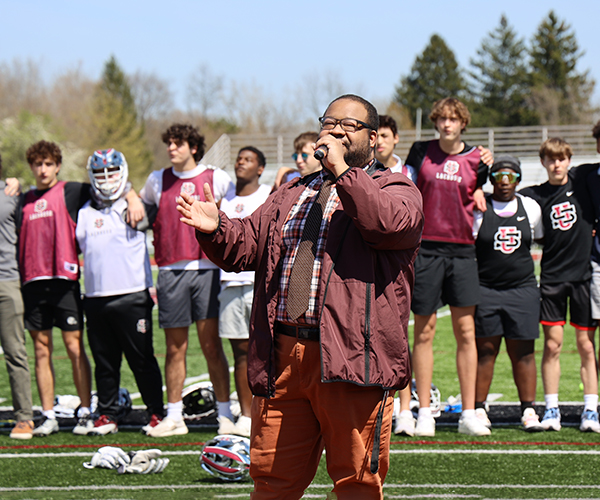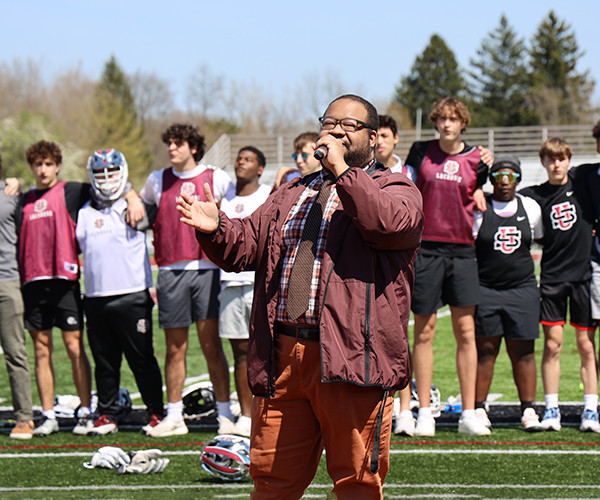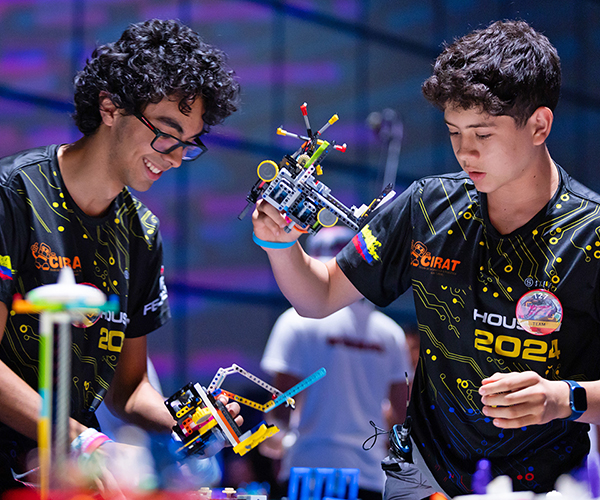A beach cleanup day for Lake Catholic students goes beyond service and sanitation — it’s more than tossing washed-up plastics and scattered litter into trash bags. While important, the lesson extends into quantifying their environmental impact.
“They take the various types of trash, measure it, see how much waste is out there and they see the outcome and how they are helping,” explains STEM teacher Mary Ridler.
It’s a dig-deeper mindset.
And the inquiry-based learning goes far beyond 3-D printing and laser-cutting prototypes, though certainly those are skills students gain in an environment centered on science, technology, engineering and math. Ultimately, STEM is about problem-solving.
It’s learning by failing forward.
“When we think of STEM, we don’t think of silos, instead it’s how to integrate skillsets of design thinking, prototyping, modeling, changing, knowing your audience,” says Colleen Greller, associate dean of curriculum and instruction at Magnificat High School. “These are important skillsets applicable to any career — and not just science and math but also
humanities and art classes.”
STEM is embedded into modern curriculum in unexpected ways.
Take a theater tech class at Magnificat where students use 3-D modeling software to design a set, then gather feedback so they can make changes. Through the school’s partnership with Cleveland’s Motogo, girls can spend a semester learning to deconstruct and rebuild a motorcycle engine. One 2020 graduate told Greller, “Before this, I didn’t know the difference between a wrench and a pair of pliers.”
Students wear garage jumpsuits and team up in groups of four per workbench. Every day, they create a video log explaining what they accomplished, what worked, what didn’t and how they overcame obstacles. On Kickstart Day, they test the bikes.
“The glee on their faces when the engines start is amazing — they never saw themselves being able to succeed at this,” Greller relates.
One student went on to intern with Motogo and is now pursuing a career in mechanical engineering after participating in the course. In fact, 43% of Magnificat graduating seniors last year planned to enter a STEM field.
Immersive, STEAM (add the A for art) education helps students explore and discover, says Kimberly Corrigan, director of STEM engagement and science teacher at Laurel School. “The idea is to push them to break their own boundaries.”
A Different Way to Learn
Beyond offering specific STEM programs, schools are embracing this way of learning by connecting teachers across disciplines to develop multi-faceted projects, along with remodeling curriculum to encourage students to learn by doing — and undoing and trying again.
“It’s a cycle,” Greller acknowledges. “What it teaches kids is the importance of lifelong learning. We are never there. We never have the perfect answer. We must continue building and thinking and changing as different situations occur.”
Frankly, this can be frustrating. But that’s a good thing.
“A lot of times, students expect to get the answer right away or believe there is a ‘right’ answer, and in those ‘aha’ STEM moments, they come to realize they can embrace the creative process of problem solving and using evidence-based decision making,” Corrigan says. “They get to discover information rather than being told information.”
For instance, one climate change lesson at Laurel included designing and building an enclosed system. “We learned about photosynthesis and food webs and a balanced ecosystem, and students collected data to see if their ecosystems were successful,” Corrigan relates.
Engineering students were charged with creating a teacher’s chair out of cardboard. “They had to 'undo' the math involved and figure out how to support my weight. The point is to push them beyond what they think they can do.”
So, what does STEM actually look like when it’s integrated into the syllabus?
The learning is, in many ways, “a backward approach” that is unlike the traditional method of teach and test, says Lacy Chick, co-director of Hawken’s STEM program. “Students do an inquiry-based lab where they go in with some questions and make inferences,” she says. “We want students to not just learn science but to understand why it’s important.”
Aside from working STEM into classwork, Hawken offers a three-semester STEM program that provides a full journey through the scientific process. It begins with learning how to research and identify credible sources and then moves into a mentorship experience.
During summer, students spend time in a lab or the field as interns. Then in fall, they learn about science communications. “They gain professional development skills like resume building, how to communicate with professionals,” Chick says. “It’s about learning from what failed or from the information you just discovered.”
STEM teaches independence, Ridler points out. “Students gain confidence. They learn how to communicate, collaborate and understand that it is OK to fail, pick up the pieces and move on. Review, revamp and respond.”
Growing Life Skills
STEM concepts connect us to the world. The Cleveland Metroparks helps visitors and students realize this in hands-on ways, including with its STEM Cart, which is about the size of an old-fashioned hot-dog cart on wheels. It offers a pop-up way for people to do science.
“At the North Chagrin Reservation, we have an aviary where owls are rehabilitated, so we did a STEM Cart with owl pellet dissection,” describes Mary Rouse, director of outdoor experiences.
Guests can use digital Celestron microscopes that are worn around the neck and about the size of a traditional camera. “That way, they can explore moments up close,” Rouse relates.
A three-day STEM camp experience at North Chagrin offers a different theme for each day, covering the same grounds.
“One day they might take a hand lens to see what is on the ground, and then a thermometer to see what they find out, or they use cameras,” Rouse says. “Then we use experiments, trial and error to better understand what we’re finding, and on the last day it’s about understanding how to protect the natural world and habitat.”
Rouse says, “STEM is an inquiry-based approach to life — a larger view of how we learn and how to explore the world around you.”
And this appeals to all types of learners, making STEM universally accessible, points out Ridler.
“In this tech age, kids don’t do so well with just the book learning — they need something tangible,” she explains.
“Students who learn better hands-on have the ability to learn that way, and those who learn best by books have that same ability because we incorporate it all. It’s research, writing… They are being taught the same skills, but it suits individual learning styles.”
Students also become the teachers in STEM environments, practicing skills by explaining concepts to classmates.
“And as teachers, we become more like coaches,” Ridler says. “There might be a student who can explain a concept in a different and even more understandable way. They help each other out, and it’s really fun when they come together and say, ‘What if we try it this way?’ Teachers are open to the understanding that kids can teach us, too. It works both ways."




